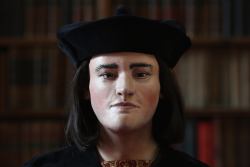5 February 2013
Dundee experts reconstruct face of Richard III 528 years after his death
- Facial reconstruction reveals face of long dead King
- A more pleasant, younger and fuller appearance than period portraits reveal
- A face far removed from the image of the cold-blooded villain of Shakespeare's play
- Opportunity to look into the eyes of one of English history's most controversial and unfairly maligned kings

Credit both photos to Richard III Society
The Richard III Society will today unveil the world's only facial reconstruction of the human remains found at the Greyfriars in Leicester, yesterday confirmed as belonging to Richard III.
The reconstruction project, led by Caroline Wilkinson, Professor of Craniofacial Identification at the University of Dundee, was commissioned and funded by the Richard III Society.

The calm and apparently thoughtful face is in stark contrast to the many portrayals of Richard III, showing contorted facial and bodily features, that were created for political reasons following his death.
Examination of the remains have shown that Richard had no kyphosis or withered arm, despite this being a feature commonly attributed to him and his face is shown to be warm, young, earnest and rather serious.
"It was a great privilege for us all in the Dundee team to work on this important investigation," said Professor Wilkinson. "It has been enormously exciting to rebuild and visualise the face that could be Richard III, and this depiction may allow us to see the King in a different light.
"His facial structure was produced using a scientific approach, based on anatomical assessment and interpretation, and a 3D replication process known as stereolithography. The final head was painted and textured with glass eyes and a wig, using the portraits as reference, to create a realistic and regal appearance."
Her colleague Janice Aitken, a lecturer at Duncan of Jordanstone College of Art & Design (DJCAD), part of the University, painted the 3D replica of the head that Professor Wilkinson created.
"My part in the process was purely interpretive rather than scientific," she said. "Guided by Professor Wilkinson's expertise, I drew on my experience in portrait painting, using a combination of historical and contemporary references to create a finished surface texture. The reaction of the team when the model was unveiled made all the hard work worthwhile."
Dr Phil Stone, chairman of the Richard III Society expressed his delight at the work that the Dundee team carried out, saying, "It's an interesting face, younger and fuller than we have been used to seeing, less careworn, and with the hint of a smile. When I first saw it, I thought there is enough of the portraits about it for it to be King Richard but not enough to suggest they have been copied.
"I think people will like it. He's a man who lived. Indeed, when I looked him in the eye, 'Good King Richard' seemed alive and about to speak. At last, it seems, we have the true image of Richard III - is this the face that launched a thousand myths?"
The facial reconstruction will eventually be loaned to Leicester City Council to be displayed in their planned visitors centre adjacent to the Greyfriars site. The centre will be dedicated to telling the story of King Richard III's life and death. The excavation, analysis and reconstruction was driven by Phillipa Langley, the originator of the 'Looking for Richard' project.
"Seeing a true likeness of England's last Plantagenet and warrior king meant, for me, finally coming face-to-face with the man I'd invested four years searching for," she said.
"The experience was breathtaking -- one of the most overwhelming moments of my life. I wasn't alone in finding this an approachable, kindly face, almost inviting conversation.
"Perhaps I may be forgiven for adding a personal impression of loyalty and steadfastness, someone seemingly capable of deep thought. An entirely new interpretation, but to me, instantly recognisable for who he was. You must make up your own mind, but I can only say I was transfixed."
Notes to editors:
About the Richard III Society
With a worldwide membership and local branches the Society is actively engaged in original research through its own initiatives and through collaboration with other institutions bodies and scholars. Through the Richard III and Yorkist History Trust, a charitable body established by the Society, we publish important academic works and make research grants
The Society publishes an annual journal, The Ricardian, with original articles on fifteenth century history and a quarterly members' magazine the Ricardian Bulletin.
Members of the Richard III Society are available for media interview on any topic concerning the life and times of Richard III, the Leicester dig or any related matter.
For media enquiries contact:
Grant Hill
Press Officer
University of Dundee
Nethergate, Dundee, DD1 4HN
TEL: 01382 384768
E-MAIL: g.hill@dundee.ac.uk
MOBILE: 07854 953277 |

